
Source REUTERS / Vasily Fedosenko
Hello, Habr.
2020 is issued to the eventful. The scenario of a color revolution is flourishing in Belarus. I propose to abstract from emotions and try to look at the available data on color revolutions in terms of data. Consider the possible success factors as well as the economic consequences of such revolutions.
Anyone interested - please, under cat.
Approx. Vicki: The term "color revolution" has no precise definition, researchers describe the reasons, goals and ways of their implementation in different ways. Sometimes the term is interpreted as a change of ruling regimes carried out with the predominant use of methods of non-violent political struggle (usually mass street protests).
The fact that it is the color revolution that is taking place in Belarus is taken from the words of A.G. Lukashenko.
Dataset
All 33 color revolutions were taken (the term is what it is. The author continues to use this term, including for failed color coups and coups), according to the source, which served as Wikipedia , for lack of a better.
The categories were taken:
- country [ country ]
- [start_date] [end_date]. , .
- [reason] — , : [politics], [election], [economics], [corruption]
- [success] — .
- . . ( )[participants_max_min], ( ) [participants_max_max] [av_participants].
- [population]
- [cur_leader_elected]. , ,
- [cur_elected_dob]
- Press Freedom Index in the year the protests began [ press_freedom_index (PFI) ]. The higher, the more not free
- Country position in the press freedom index in the year the protests began [ press_freedom_index_pos (PFI_pos) ]

Generation of new features / categories.
The duration of the protests in days [ duration ], the time in power in years [ days_since_1st_election ], the age of the lookout at the time of the beginning of the movement [ years_since_dob ], and the proportion of protesters from the country's population [ protest_ratio ] are easily calculated .
Drove
The article contains some statistical calculations. There is not much data, but how much is there. The author asks in advance to understand-forgive
The graphs will show only three categories of reasons for protests (politics, election, economics) as the most interesting.
Box plot
Box plot, or "box with a mustache", can be clearly illustrated with this figure:

Duration of protests
The first thing the author decided to study was the duration of the protests that took place.
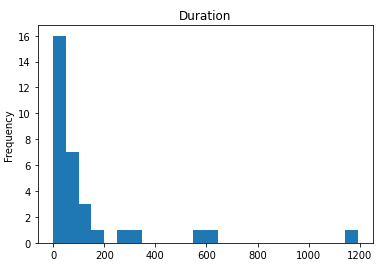
Based on the histogram, the main duration of protests lasts up to 200 days. It is interesting how long successful and unsuccessful protests lasted, depending on the cause:
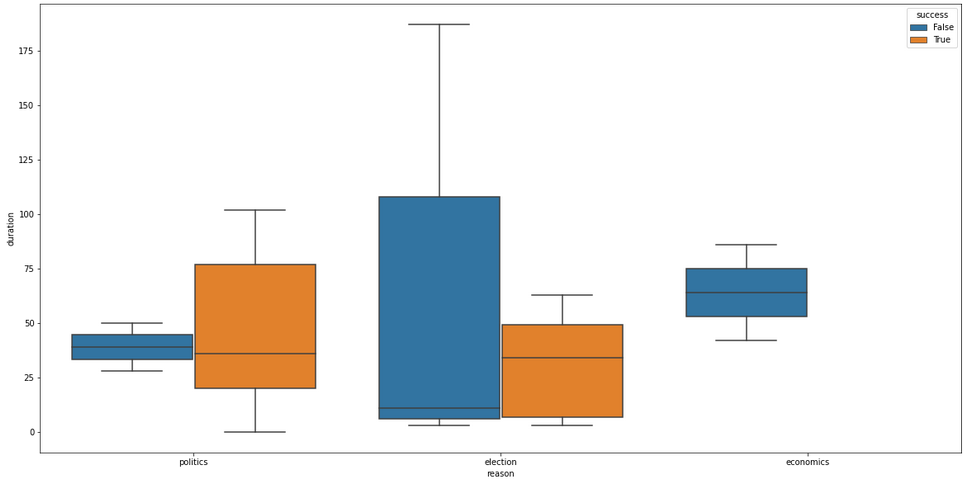
The distribution of the categories of politics and election is significantly different. Due to the fact that the protests in Belarus were caused by the results of the elections, let us dwell in more detail on this table and this graph:
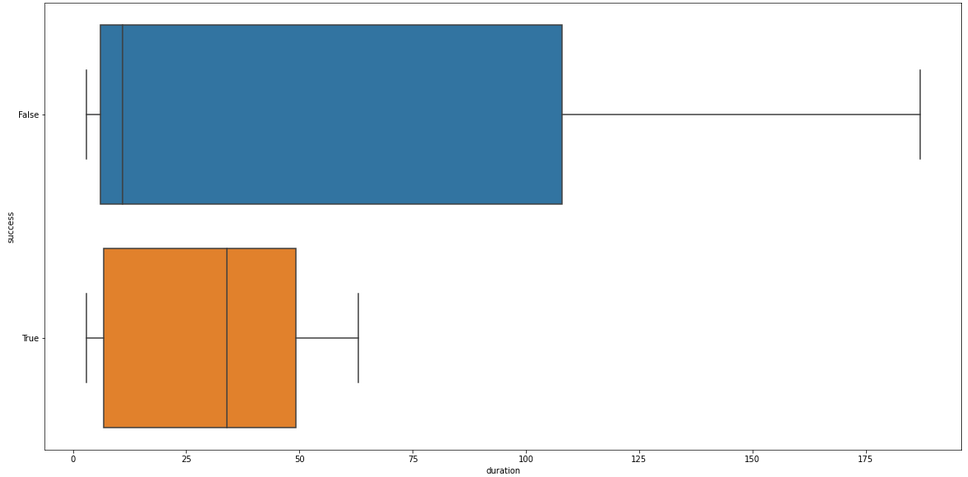
Based on the available data, we can conclude that the "golden time" for a successful protest is approximately 6-8 weeks. The political scientist would probably note that the low median False is due to the fact that some of the protests were quickly stifled in the bud. If this could not be done, the best strategy was to wait and drag out the protest. The author analyzed separately that no one calls elections at the beginning of summer (June, July).
The situation in Belarus at the time of publication (08/31/2020) - 21 days aka 3 weeks have passed since the beginning of the protests.
Term in power
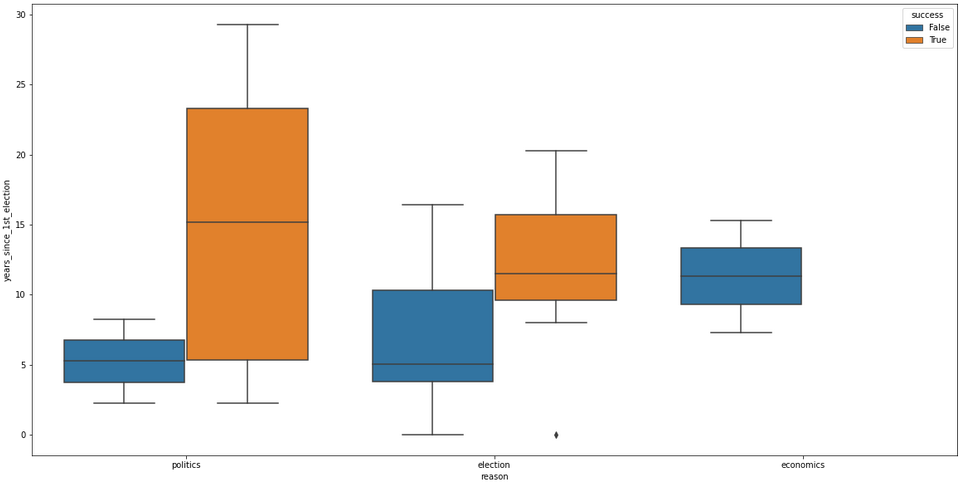
As you can see from the above boxplot, the longer you are in power, the more difficult it is to keep it as a result of the color revolution. Let's take a closer look at the situation around the elections:
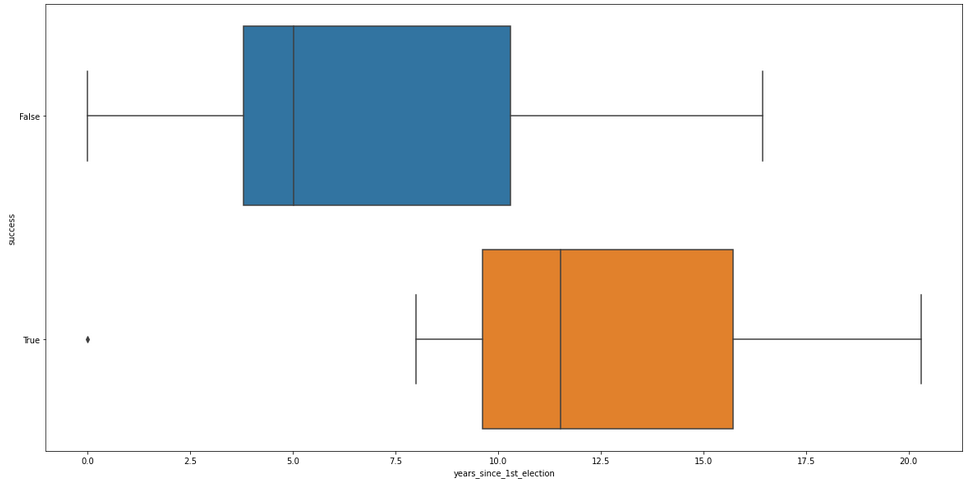
From the graph you can see that the people's patience is about 2 times and the quartiles practically do not overlap.
The situation in Belarus is unique in its way. There has not yet been a color revolution in a country where the ruler was in power for 26 years and went for the 6th term. On the other hand, it is quite easy for the author to present the result of the decision tree algorithm, for which this question will not cause problems.
Age of the power holder
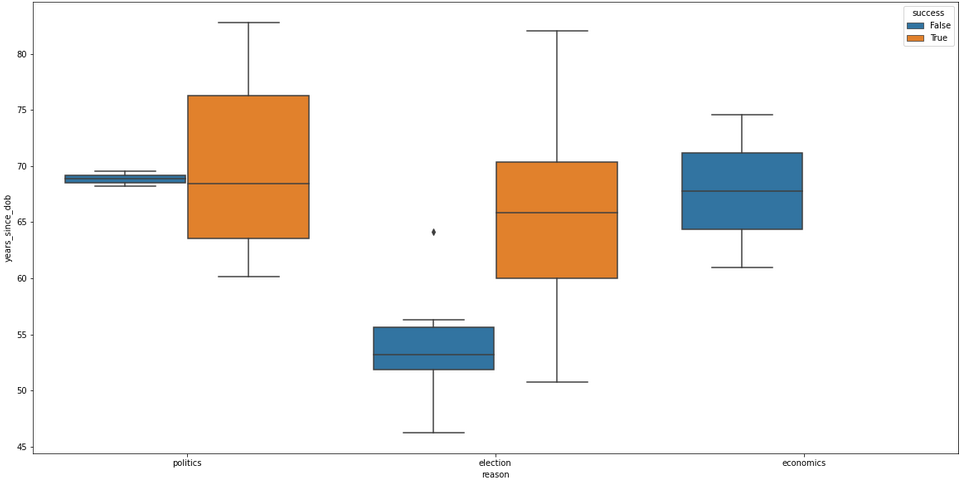
This graph shows how different distributions take place (no wonder with such and such amount of data). Let's take a closer look at the election graph:
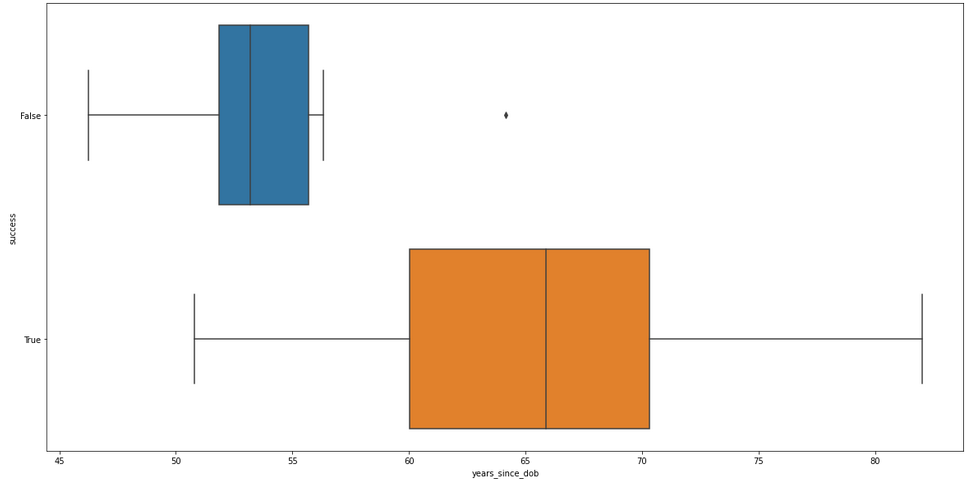
As in the example above, the quartiles of these boxplots do not overlap. Perhaps this is due to the fact that young and energetic politicians under 55 have more strength to resist colored protests. Or with the time when they got the power and how reluctantly they part with it. Who knows?
The incumbent president of Belarus turned 66 yesterday (or today?). In this case, the numbers are not in his favor.
Index of (in) freedom of the press
According to the opinions of people much smarter than the author, the lack of freedom of the press can serve as a signal of dictatorial inclinations. The Press Freedom Index is calculated by Reporters Without Borders. The higher the index, the worse things are with freedom of the press, according to this organization.
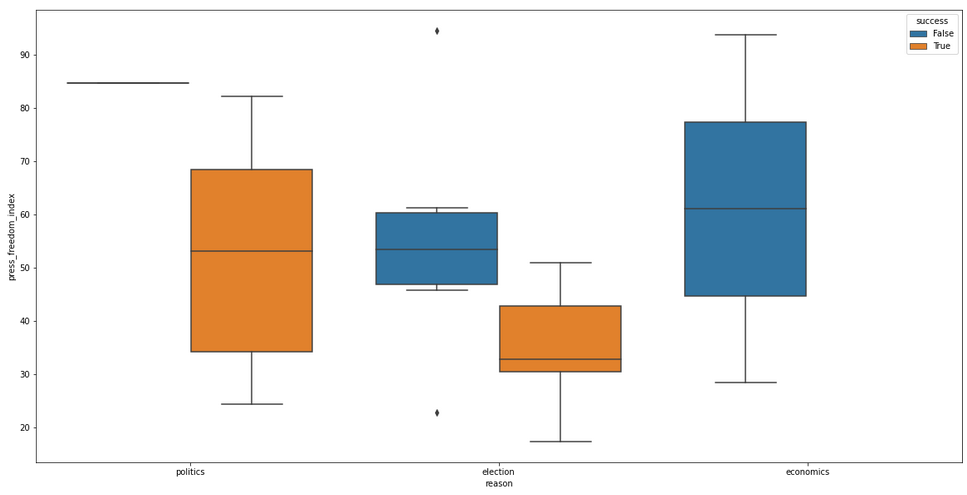
Based on these graphs, the presence of freedom of the press is bad for the retention of power. This is understandable, since the role of the press and TV, although weakening, still plays a rather important role. Consider the election situation:
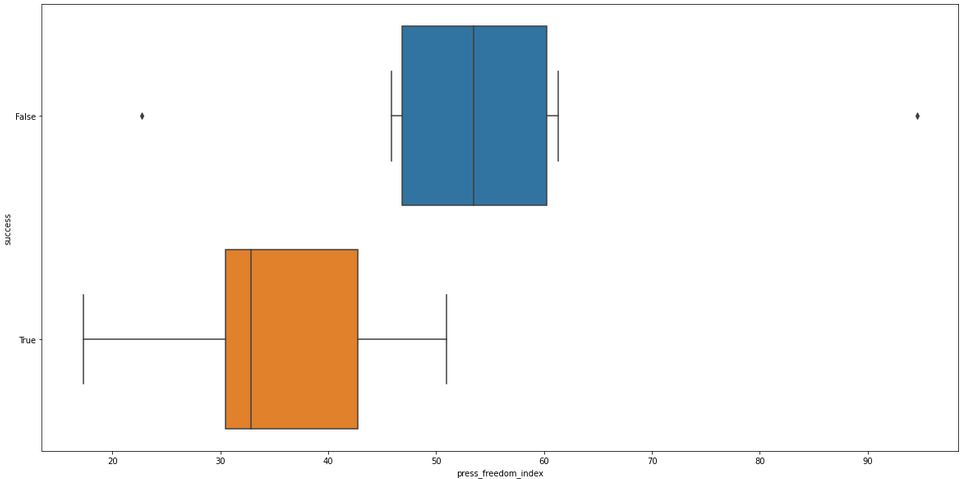
As in the previous cases, the quartiles did not overlap. The arrival of various social networks has significantly changed the picture and the influence of media resources, in this regard, it seems possible for the author to put 1986 in the Philippines and 2020 in Belarus on a par, but it is difficult.
49.25 2020 . , . . - . , . , . , , .
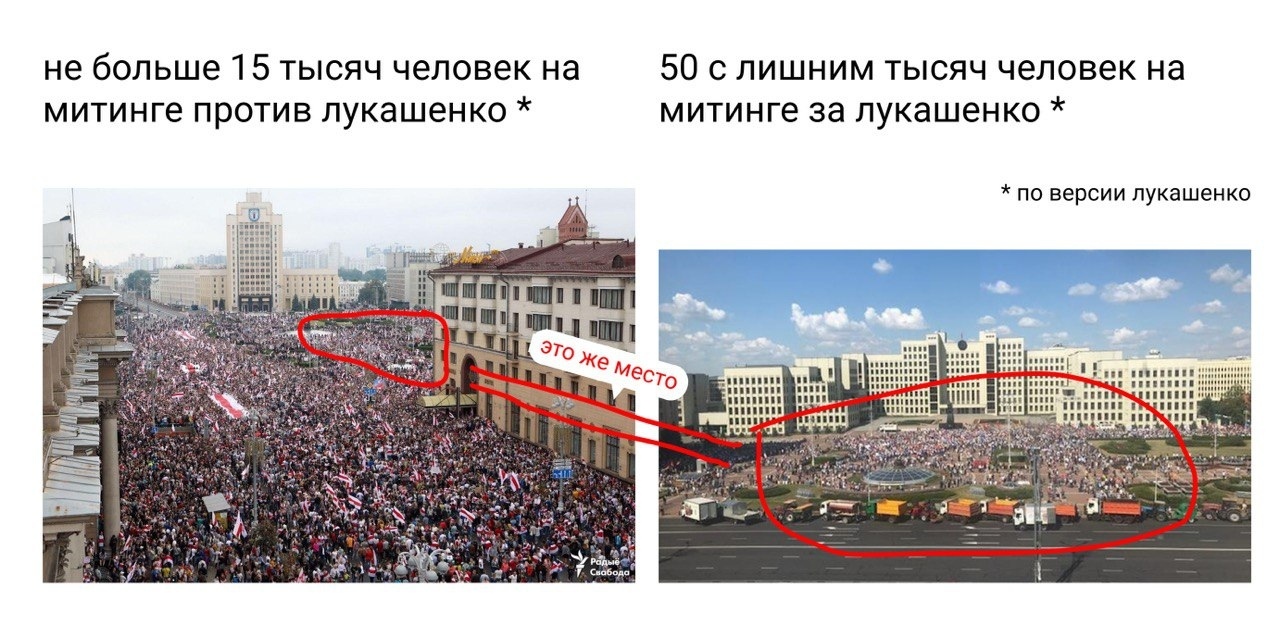
Perhaps one of the most difficult to read parameters. It seems that at rock concerts or other mass events, the media and authorities assess the number of participants approximately the same.
But when information about the protests in different countries appears, the impression is created that they were in different places. Or looked through binoculars from different ends. One way or another, the data were considered the same for everyone, so there is a chance that they are comparable.
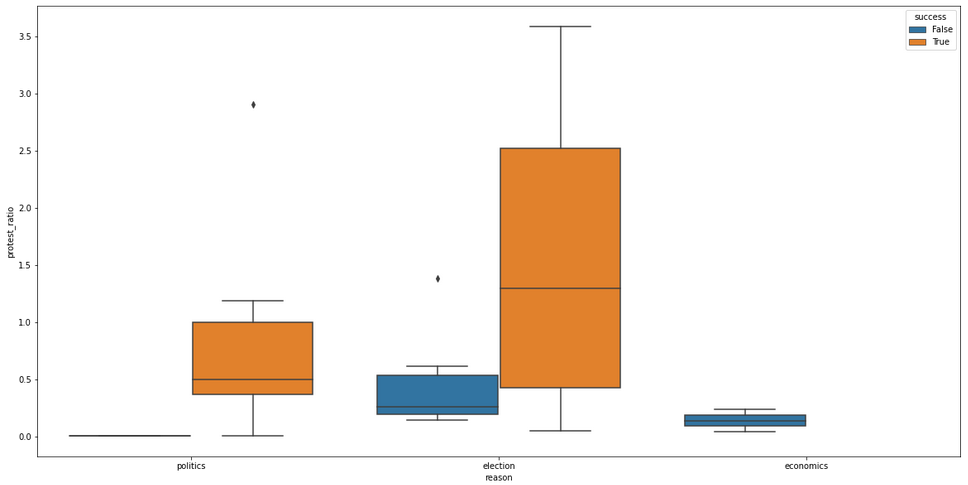
The graphs show that the larger the proportion of protesters, the more difficult it is to retain power. Expected. Rather, the numbers themselves are of interest, including for the situation related to elections:

Judging by the boxplot, the critical mass is 0.5%. There was only a single case, regarded as an outlier, when almost 1.4% did not reach their target ( Armenia, 2008 ).
In Belarus, at the moment, according to the calculated formula, 1.33% are participating in the protests. This figure also does not play into the hands of the current government.
Implications for the economy
What will be below can hardly be called an economy. The author did not find a better parameter for comparison, how to study the volatility of the national currency rate according to the National Bank's version against the US dollar. To complete the picture, a period of one year was taken from the beginning of the protests and a year after the end. The protest times are highlighted in blue on the graphs.
The national currency is strengthening against the dollar
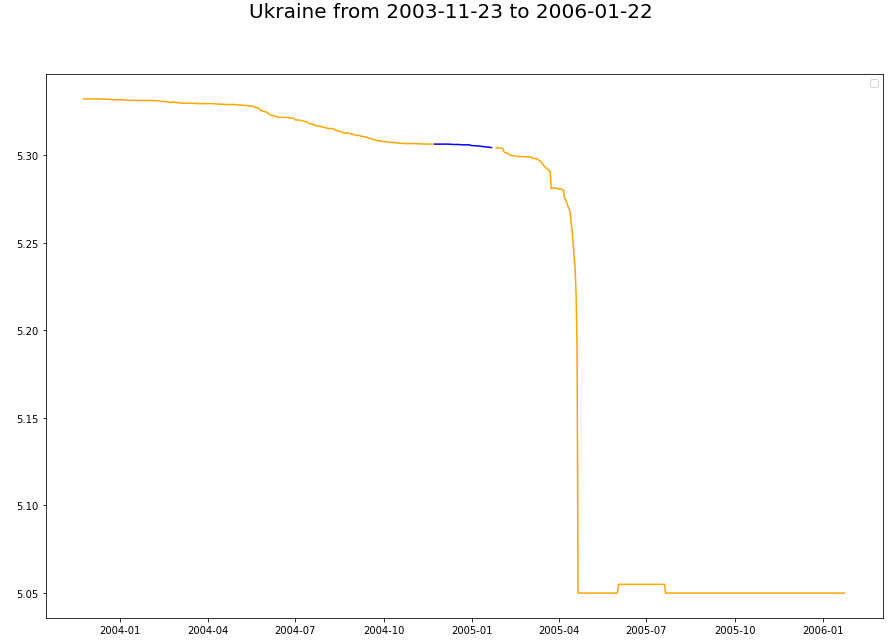 |
 |
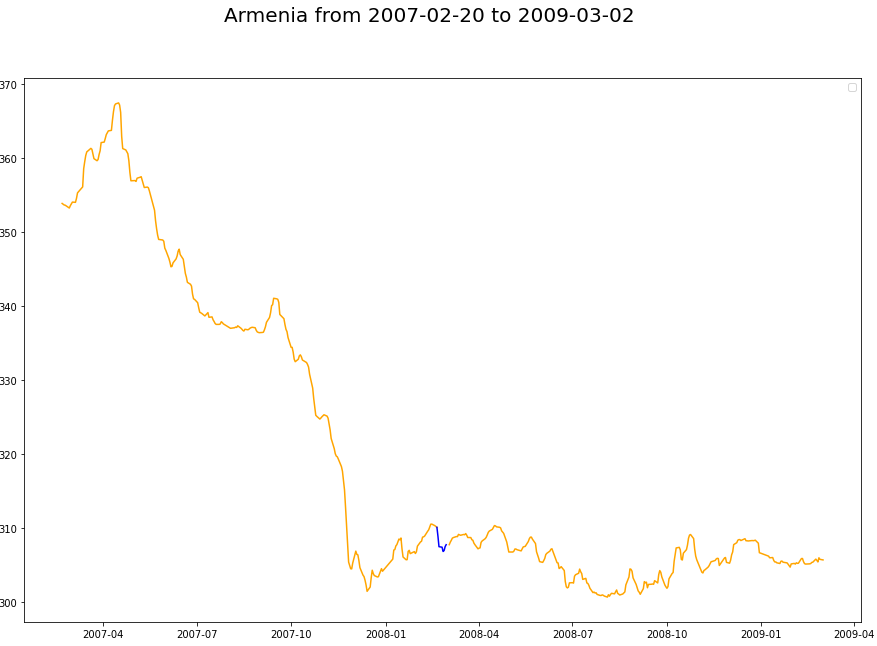 |
 |
A similar scenario was observed several times in the countries of the former Soviet Union. All things being equal, salaries in US rubles have grown since then.
The national currency is relatively stable against the dollar
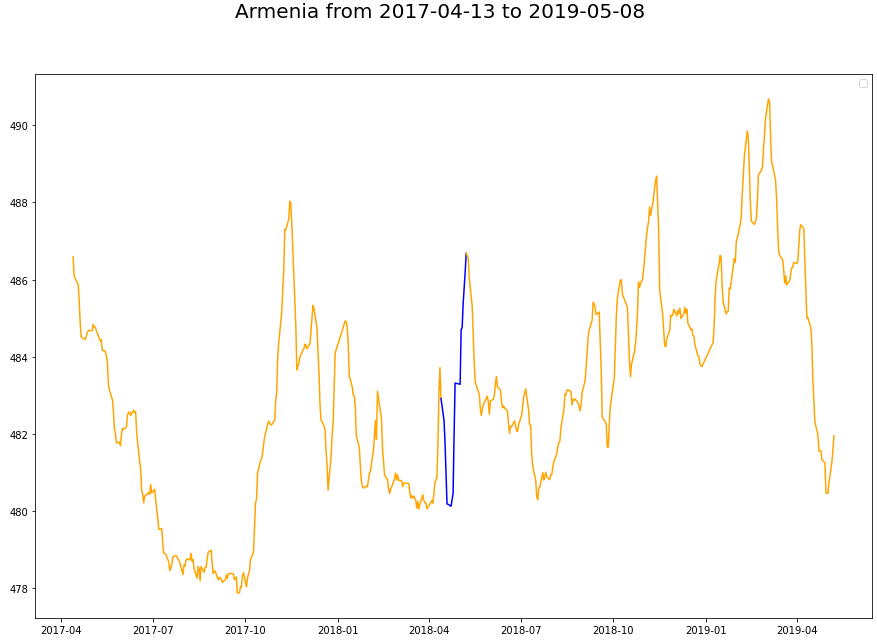 |
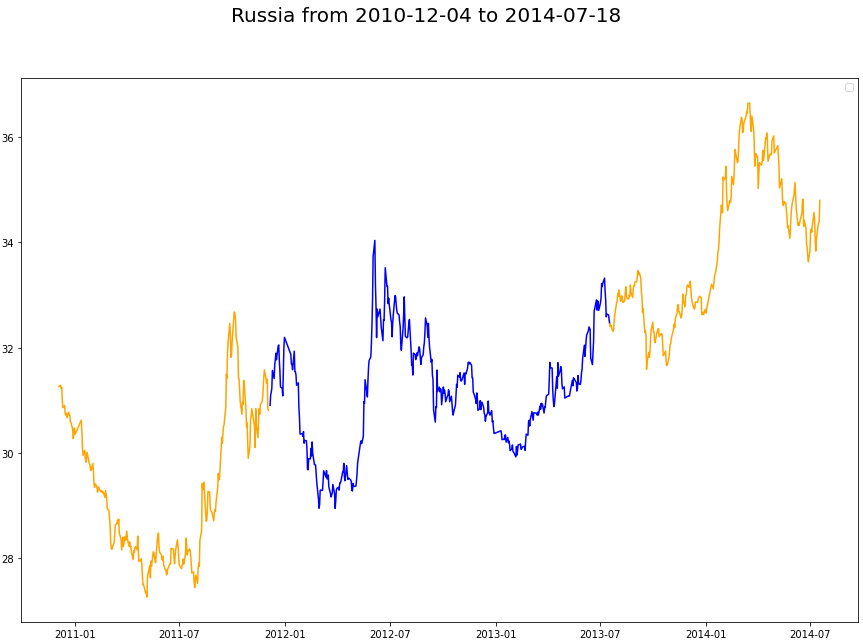 |
 |
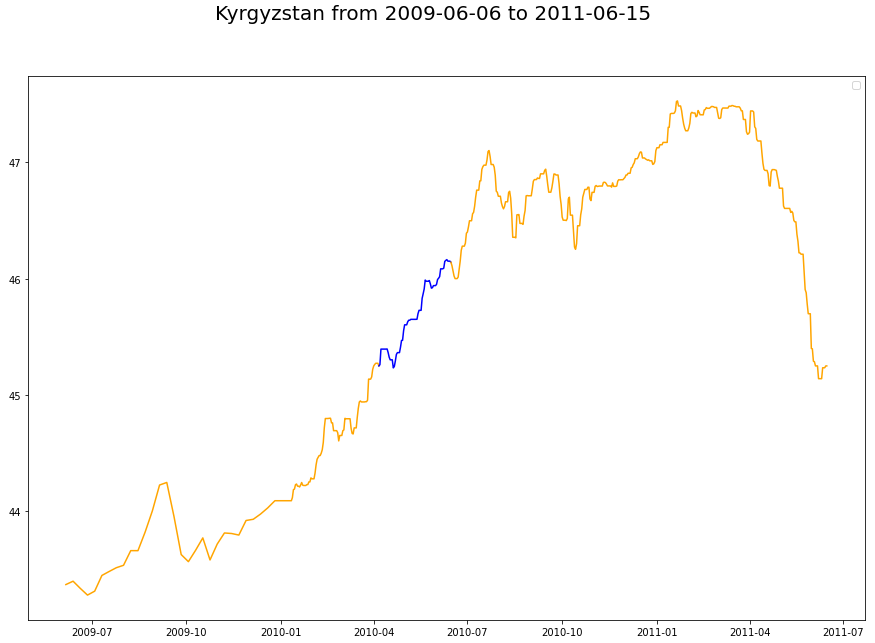 |
The stable qualities of national currencies were also noted in some of the colored scenarios of the revolutions of the countries of the former union. In these cases, the dollar exchange rate changed relatively little.
The national currency fell against the dollar
 |
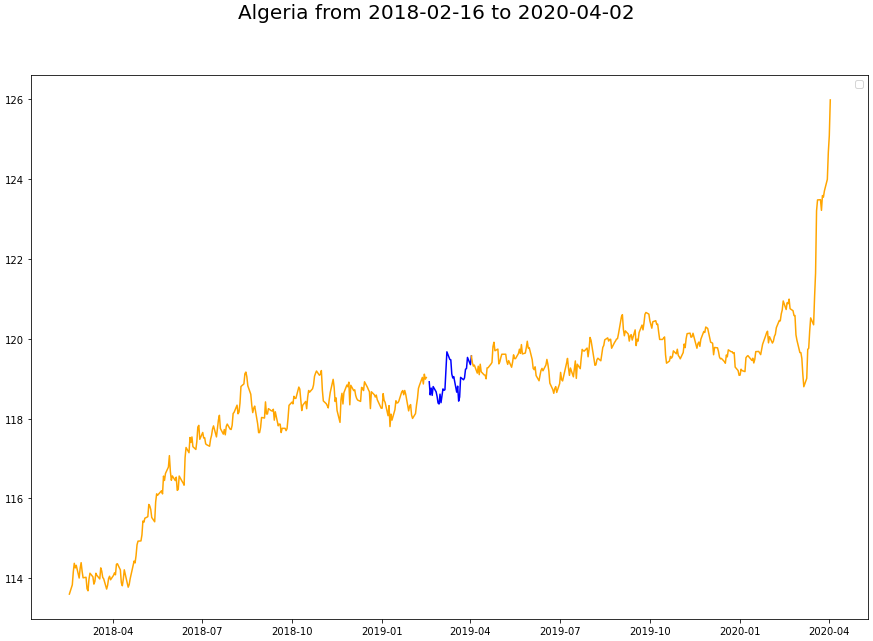 |
 |
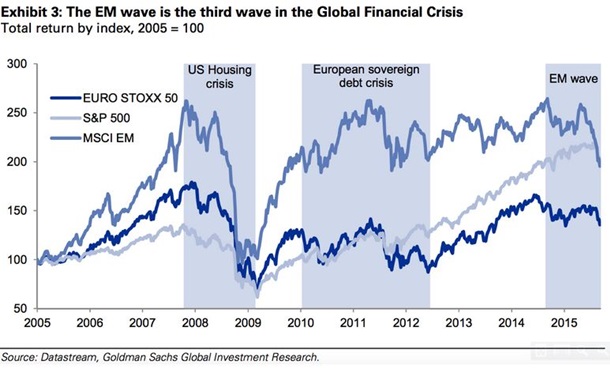 |
A year after the end of some of the protests, one could see an extremely deplorable situation regarding the national currency. Perhaps, the last two phases of the 2008 economic crisis contributed. The situation with Algeria is quite fresh - a local dinar knocked down COVID-19.
Current situation in Belarus
 |
The situation in Belarus is quite difficult - earlier during the protests, only in Russia in 2012 , the exchange rate dropped sharply by more than 10%. However, this took place far from the first days of the protests and during the second phase of the global financial crisis. The author does not possess any valuable knowledge in the field of economics and does not want to mislead people about the causes and consequences of the current situation.
Dry residue
Although there is little data, they are quite convergent, which is good news. Some observations and patterns are easy to interpret, some a little more complicated.
The situation in Belarus changes in a day, and what will be clear next to only a few.
Finally, I will give a t-SNE graph of color revolutions. All dates, non-numeric parameters and the result of revolutions were removed from the dataset.
Successful revolutions are marked in green, unsuccessful ones - in red. Venezuela is marked in blue, and the current situation in Belarus is marked in gray. The black dot marks the position where Belarus will be in 2 weeks, with the rest of the data fixed.
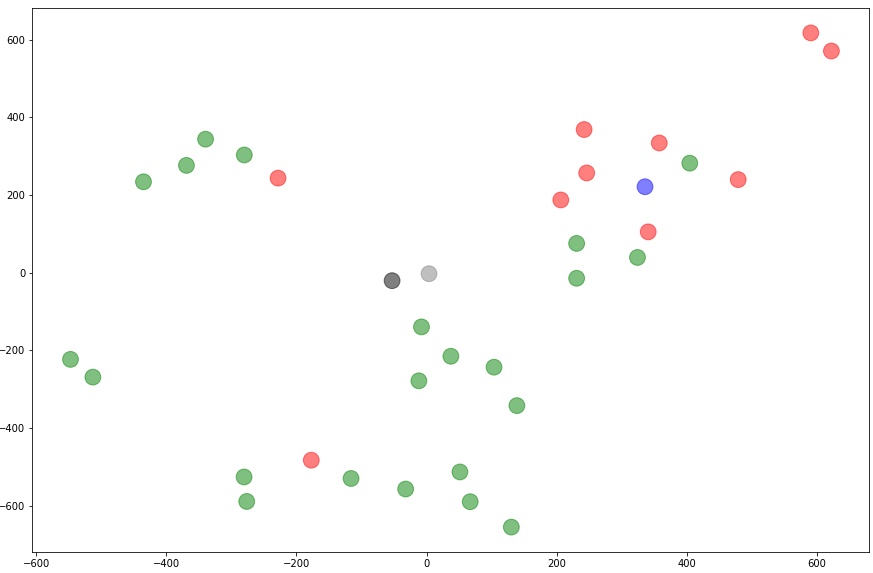 |
 |
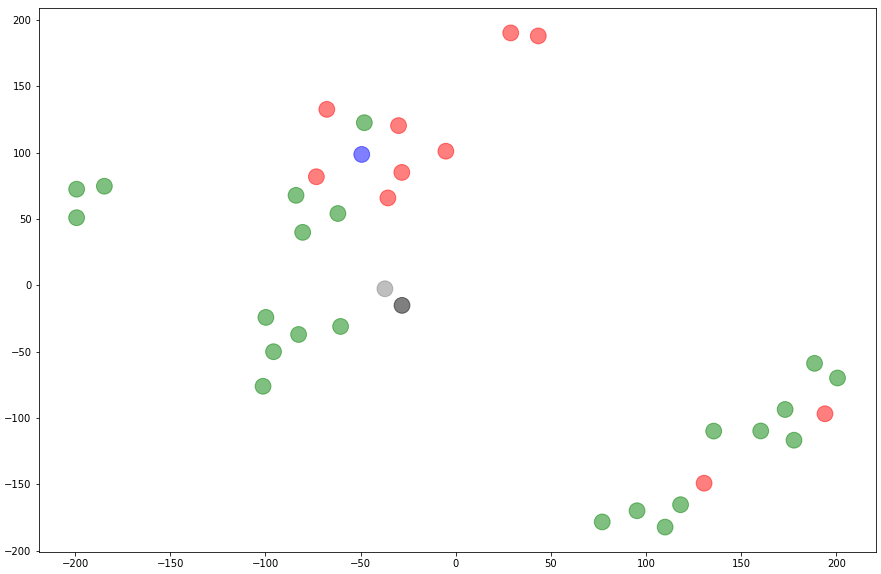 |
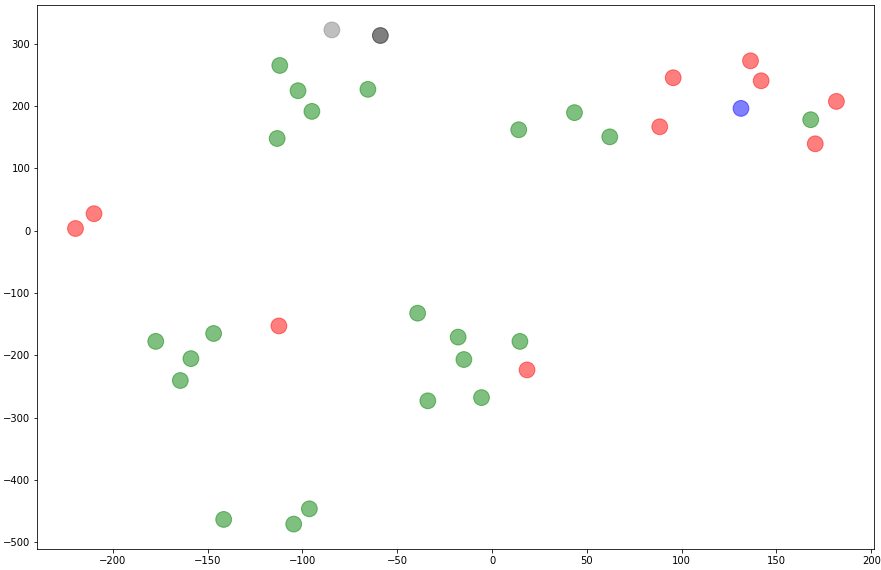 |
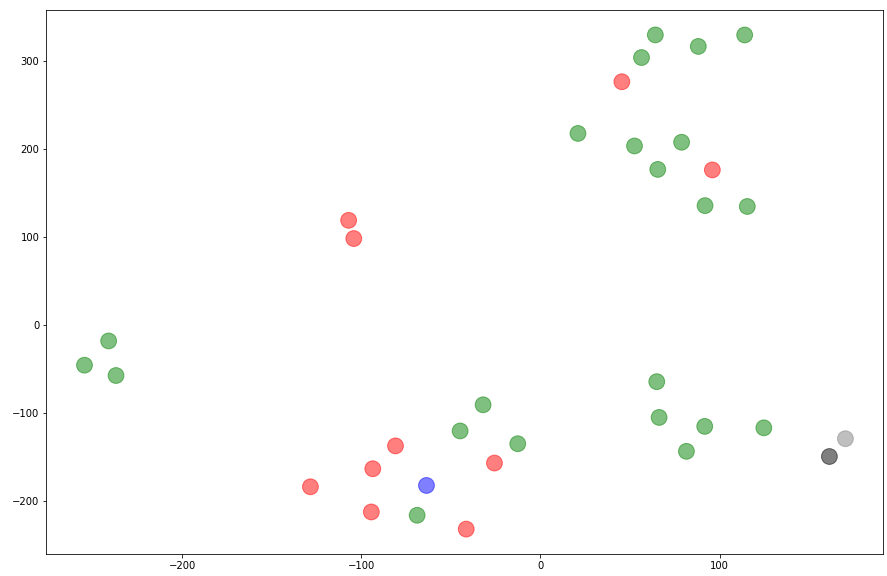 |
|
It smells a little bit of clustering here and you can try to carry out classification
You can pay attention to the fact that there is a cluster of 5 green dots next to Belarus. We are closest to the recent revolutions in Armenia (2018) and Algeria (2019) , as well as Georgia (2003) . In the same cluster, a little further off, the revolution in the Philippines (1986) and inSouth Korea (2016) .
Epilogue
The author tried to objectively, as far as possible, represent the situation with color revolutions in the graphs. The situation in Belarus does not look in favor of the current autocrat, and only time will tell whether the author is right in his forecast.
If you have ideas for new categories or topics - write, we will study together.
"There are three types of lies: lies, blatant lies and statistics" (M. Twain)